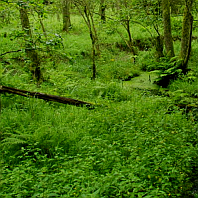These days –late March and early April– are a delight for birdwatchers. Many species are busy carrying material with which to nest, and males sing unceasingly with all their strength to mark their territory. At this time some species are easily seen, while later, when they are already breeding, they will be much less bold, so that no predator detects where the chicks hide. For example, feeding among the leaves of the same grey willow we can easily see four species of tits: the coal tit (Parus ater), the blue tit (Parus caeruleus), the great tit (Parus major) and the long-tailed tit (Aegithalos caudatus). Later on we will only seem them fleetingly go past.
But it is also a time to admire the natural landscape. Different tree species are coming into leaf, and changing their colour as they grow. The most advanced trees were the grey willows, with a bluish green colour that will turn to greyish green later on. Silver birches show a vivid green that contrasts with their white bark. Coppery leaves emerge from English oaks, which become green as they grow. Sweet chestnuts, far behind because they’ve not yet come into leaf, let us see the beautiful structure of their tops. In contrast, the dark green colour of the evergreen bay trees stands out. Thus, located at a good vantage point over a fraga (oceanic/atlantic native forest; the typical fragas contain wetland species such as oak, chestnut, holly and birch) we can clearly determine the composition of the indigenous forest.
From the centre of Fragas do Mandeo we see a small fraga of old oaks in which the village festival is celebrated. Behind the splendour of the fraga, the hill of A Espenuca rises in the distance. Do not expect to see on its slopes that mosaic of colours. There is only the gray colour of the eucalyptus affected by the weevil. The sadness of that colour goes on downhill as far as Chelo, hemming in the indigenous forest on the riverbank and in steeper areas.
It is a pity that such an emblematic corner of the area, the viewpoint to which we used to take our visitors to see out over the valley of the River Mandeo, has no one to defend it. Who cares that it is loosing all its scenic value? What entity or individual is doing something to reverse the situation?
In Fragas do Mandeo we are trying. Give us a hand!



















